Taurus is a large constellation in the northern sky. Its name means “bull” in Latin. The constellation is symbolized by the bull’s head, ♉. It is one of the oldest constellations. Its history dates back to the Bronze Age.
Taurus is one of the 12 constellations of the zodiac, first catalogued by the Greek astronomer Claudius Ptolemy in the 2nd century CE. In Greek mythology, the constellation is associated with Zeus, who transformed himself into a bull to get close to Europa and abduct her.
Taurus is known for its bright stars Aldebaran, Elnath, and Alcyone, as well as for the variable star T Tauri. The constellation is also home to the Pleiades (Messier 45), also known as the Seven Sisters, and the Hyades, the two nearest open star clusters to Earth.
Taurus has a number of other well-known deep sky objects. These include the supernova remnants Messier 1 (the Crab Nebula) and Simeis 147 (the Spaghetti Nebula), Hind’s Variable Nebula (NGC 1555), the colliding galaxies NGC 1410 and NGC 1409, the Crystal Ball Nebula (NGC 1514), and the Merope Nebula (NGC 1435).
Facts, location and map
Taurus is the 17th largest constellation in the sky, occupying an area of 797 square degrees. It is one of the 15 equatorial constellations. It is located in the first quadrant of the northern hemisphere (NQ1) and can be seen at latitudes between +90° and -65°. The neighboring constellations are Aries, Auriga, Cetus, Eridanus, Gemini, Orion and Perseus.
The constellation name Taurus is pronounced /ˈtɔːrəs/. In English, the constellation is known as the Bull. The genitive form of Taurus, used in star names, is Tauri (pronunciation: /ˈtɔːraɪ/). The three-letter abbreviation, adopted by the International Astronomical Union (IAU) in 1922, is Tau.
Taurus belongs to the zodiac family of constellations, along with Aries, Gemini, Cancer, Leo, Virgo, Libra, Scorpius, Sagittarius, Capricornus and Pisces.
Taurus contains two Messier objects – Messier 1 (M1, NGC 1952, Crab Nebula) and Messier 45 (the Pleiades) – and has five stars that may have planets in their orbits. The brightest star in the constellation is Aldebaran, Alpha Tauri, with an apparent magnitude of 0.85. Aldebaran is also the 13th brightest star in the sky. There are two meteor showers associated with the constellation; the Taurids and the Beta Taurids. The Taurids peak in November, while the Beta Taurids can be seen in June and July.
Taurus contains 17 formally named stars. The star names approved by the International Astronomical Union (IAU) are Ain, Alcyone, Aldebaran, Asterope, Atlas, Celaeno, Chamukuy, Electra, Elnath, Hoggar, Maia, Merope, Pleione, Prima Hyadum, Secunda Hyadum, Taygeta, and Tianguan.
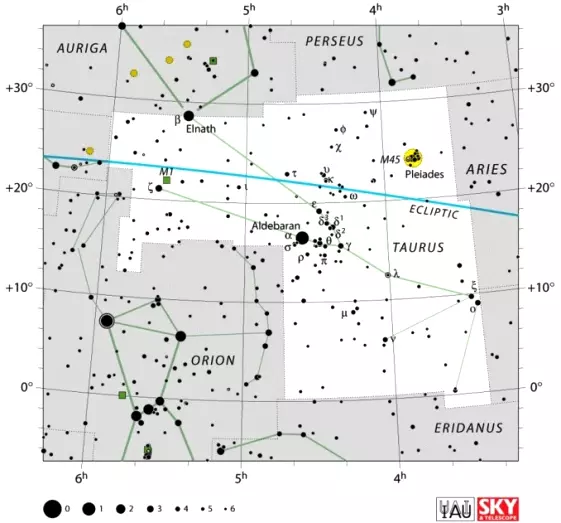
Taurus constellation map by IAU and Sky&Telescope magazine
Myth
Taurus constellation has been known since at least the Early Bronze Age, when it marked the Sun’s location during the spring equinox. It has been associated with the bull in many cultures and mythologies: Greek and Egyptian among other, and even going back to Ancient Babylon.
Depictions of Taurus and the Pleiades star cluster have even been found in a cave painting at Lascaux, dating back to 15,000 BC. Both the constellation and the Pleiades have been known in many indigenous cultures and referred to as the bull and the seven sisters, which indicates a common origin for the names.
In Greek mythology, Taurus is usually associated with Zeus, who adopted the shape of a bull in order to seduce and abduct Europa, the beautiful daughter of the Phoenician King Agenor.
Zeus mingled with the king’s herd and, being the most handsome bull there, he got Europa’s attention. The princess admired the bull and, when she sat on his back, he rose and headed for the sea. Zeus carried Europa all the way to the island of Crete, where he revealed his true identity and lavished the princess with presents.
The two had three sons together, including Minos, who grew up to be the famous king of Crete, who built the palace at Knossos where bull games were held and who also sacrificed seven young boys and girls to the Minotaur each year. Zeus later commemorated the bull by placing it among the stars.
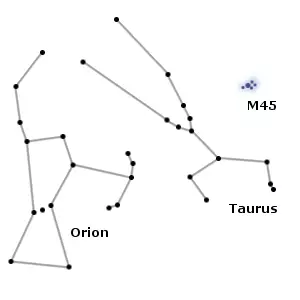
Constellations Orion and Taurus, image: Dumbbell at wikipedia.org
An alternative interpretation associates Taurus with the nymph Io, whose line Europa was descended from, who was also seduced by Zeus and then transformed into a heifer when the two were nearly caught by Hera.
Babylonian astronomers called the constellation MUL.APIN, or “The Heavenly Bull.” In the Epic of Gilgamesh, one of the earliest literary works from Mesopotamia, Gilgamesh faces the Bull of Heaven sent by the goddess Ishtar to defeat the hero after he had rejected her advances.
Gilgamesh is sometimes associated with the nearby Orion, another ancient constellation, and the two constellations are depicted as Gilgamesh and the bull in combat.
Taurus stars
Aldebaran – α Tauri (Alpha Tauri)
Aldebaran, Alpha Tauri, is an orange giant with an apparent magnitude varying between 0.75 and 0.95. It is the brightest star in the constellation Taurus and the 13th brightest star in the sky.
Alpha Tauri has the stellar classification K5III. It has a diameter 44.2 times that of the Sun and is about 425 times more luminous. The star lies approximately 65.1 light years from Earth. It is classified as a slow irregular variable, type LB. Its brightness varies by about 0.2 magnitudes.
Alpha Tauri’s traditional name, Aldebaran, comes from the Arabic al-dabarān, which means “the follower.” The star got this name because it appears to follow the Pleiades cluster, the Seven Sisters, across the sky.
Aldebaran is pretty easy to find in the sky as it lies in the vicinity of Orion constellation, and the three bright stars that form Orion’s Belt point in its direction.
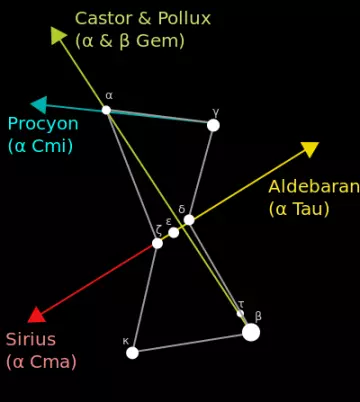
Orion can be used to find Aldebaran, Procyon, Sirius, Castor and Pollux. Image: Mysid at wikipedia.org
Aldebaran also makes it easy to find the famous Hyades cluster, as it appears to be the brightest star in it. It is, however, not a member of the cluster, but merely lies in the same line of sight. The Hyades cluster is much farther away, about 150 light years from Earth.
Aldebaran lies pretty close to the ecliptic and can be occulted by the Moon.
Elnath – β Tauri (Beta Tauri)
Elnath is the second brightest star in Taurus. It has a visual magnitude of 1.68 and is approximately 131 light years distant.
Elnath is a giant star with the stellar classification B7III. It is 700 times more luminous than the Sun. Like Aldebaran, it lies near the ecliptic and can be occulted by the Moon. The star’s proper name, Elnath, Alnath, or El Nath, is derived from the Arabic word an-naţħ, which means “the butting,” referring to the bull’s horns.
Elnath lies on the border with the constellation Auriga, the Charioteer, and has the Bayer designation Gamma Aurigae, which is not used very often anymore.
ζ Tauri (Zeta Tauri)
Zeta Tauri is a spectroscopic binary star with the stellar classification B2 IIIpe. It has a visual magnitude of 3.010 and is approximately 440 light years distant. The two components have an orbital period of roughly 133 days.
The primary component in the system is a rapid rotator, with a projected rotational velocity of 125 km/s. It has a circumstellar disk of gas. It has 11 solar masses and 5-6 times the Sun’s radius. The companion star is slightly less massive than the Sun.
θ Tauri (Theta Tauri)
Theta Tauri is another binary star in Taurus. It is one of the stars in the Hyades cluster. The two components in the system are separated by 5.62 arc minutes. The primary star is 154.4 light years distant from the solar system and the secondary is 150.4 light years away.
Theta-1 Tauri is an orange, class K giant (stellar classification K0 IIIb Fe-0.5) and the dimmer of the two components. It has a visual magnitude of 3.84. Theta-2 Tauri is a white giant belonging to the spectral class A7 III with a mean apparent magnitude of 3.40. It is a Delta Scuti variable, with variations in brightness ranging from magnitude 3.35 to 3.42 over a period of 1.82 hours.
Pectus Tauri – λ Tauri (Lambda Tauri)
Lambda Tauri is a triple star in Taurus constellation. Its Latin name is Pectus Tauri, which means “the bull’s chest.” The system has a visual magnitude of 3.47 and is approximately 480 light years distant.
The main component of Lambda Tauri is an inner pair of stars, designated Lambda Tauri AB, which orbit each other every 3.95 days and form an eclipsing binary star system similar to that of Algol in the constellation Perseus. The stars’ combined apparent magnitude varies from 3.37 to 3.91.
The primary component belongs to the spectral class B3 V. It has more than seven solar masses, 6.4 times the solar radius, and is about 5,801 times more luminous than the Sun. The star is a rapid rotator, with a projected rotational velocity of 85 km/s.
The secondary star is a subgiant of the spectral type A4 IV, about 1.9 times more massive and 128 times more luminous than the Sun. It is another fast rotator, with a velocity of 76 km/s.
The third component in the system is about half as massive as the Sun and orbits the inner pair with a period of 33.025 days.
Ain (Oculus Borealis) – ε Tauri (Epsilon Tauri)
Epsilon Tauri is an orange giant with the stellar classification K0 III. It has an apparent magnitude of 3.53 and is approximately 147 light years distant. It is located near the ecliptic and can occasionally be occulted by the Moon and, rarely, by planets.
Epsilon Tauri has an 11th magnitude companion located 182 arc seconds from the primary.
The star has the proper names Ain and Oculus Borealis, both of which mean “the eye.”
Epsilon Tauri is a member of the Hyades cluster. Its age is estimated to be about 625 million years.
A large extrasolar planet was discovered in the star’s orbit in 2007. It orbits the star every 1.6 years. It was the first planet discovered in an open cluster and it is still the only known planet in the Hyades cluster.
Hyadum I – γ Tauri (Gamma Tauri)
Gamma Tauri is another member of the Hyades cluster. It is a giant star belonging to the spectral class G8III, approximately 154 light years distant from the Sun. It has an apparent magnitude of 3.654. The star’s estimated age is somewhere between 430 and 530 million years.
Gamma Tauri has 13.4 times the solar radius and is 85 times more luminous than the Sun.
The star’s traditional name, Hyadum I, means the “First Hyad” in Latin. The star lies within 2.5 parsecs of the centre of the Hyades open cluster.
Ushakaron – ξ Tauri (Xi Tauri)
Xi Tauri is a triple star consisting of three blue-white main sequence dwarfs of the spectral type B. It is a spectroscopic and eclipsing star system. Two of the three stars are in a close orbit, and they revolve around each other once every 7.15 days. The pair orbits the third star in the system every 145 days.
Xi Tauri has a mean apparent magnitude of 3.73, with variations ranging from magnitude 3.70 to 3.79. The system is about 222 light years distant from the Sun.
δ Tauri (Delta Tauri)
Delta Tauri consists of three star systems, all of which are located in the Hyades cluster. All the stars in the Delta Tauri system lie close to the ecliptic and can be eclipsed by the Moon and very rarely by planets.
Delta-1 Tauri, also known as Eudora or Hyadum II (the Second Hyad), is a triple star system with a combined apparent magnitude of 3.77. It is approximately 153 light years distant from the Sun.
The primary component in the system is an orange giant with the stellar classification K0 III. It is 74 times brighter than the Sun and has 11.6 times the Sun’s radius. The companion is a 12th magnitude star located 107 arc seconds from the primary and believed to not be physically related to it. It orbits the primary star with a period of 530 days.
Delta-2 Tauri is a main sequence dwarf with the stellar classification A7V. It has a visual magnitude of 4.80 and is approximately 146 light years distant. It lies 0.23° away from Delta-1 Tauri.
Delta-3 Tauri, also known as Kleeia (it was after one of the Hyades sisters), is another triple star system, lying 0.72° from Delta-1 Tauri. It has an apparent magnitude of 4.30 and is approximately 148 light years distant from the solar system.
The primary component in the system is a white subgiant star of the spectral type A2IV. The star is an Alpha-2 Canum Venaticorum type variable, showing variations in brightness from magnitude 4.29 to 4.32 every 57.25 days. The star has two companions, and they are 8th and 11th magnitude stars.
Kappa Tauri
Kappa Tauri is another star system in the Hyades cluster. It is approximately 148 light years distant from the Sun.
The brightest components form a visual binary consisting of two A-type stars, a subgiant with a visual magnitude of 4.21 and a dwarf with a magnitude of 5.27. The two are 5.8 arc minutes apart.
Another binary consisting of two 9th magnitude stars lies between the two bright stars. The stars are 5.3 arc seconds apart from each other and 183 arc seconds away from the brightest component.
The Kappa Tauri system has two more companions, both of which are 12th magnitude stars.
υ Tauri (Upsilon Tauri)
Upsilon Tauri is another triple star in Taurus. It belongs to the Hyades cluster. The system has an apparent magnitude of 4.28 and is approximately 155 light years distant.
The primary component in the system is a main sequence dwarf of the spectral type A. The star is a Delta Scuti type variable, exhibiting variations in brightness from magnitude 4.28 to 4.31 every 3.56 hours. It is a spectroscopic binary star, with components separated by 0.02 arc seconds. The third component in the system is a 12th magnitude star separated by 110 arc seconds from the main pair.
119 Tauri
119 Tauri is one of the largest stars known. It has a diameter 600 times that of the Sun. It is also one of the reddest stars known, with a colour index of 2.07. The star is a red supergiant with the stellar classification M2Iab-Ib. It has a mean apparent magnitude of 4.32 and is approximately 1,802 light years distant from Earth.
119 Tauri is a semiregular variable, with variations in brightness ranging from magnitude 4.23 to 4-54 over a period of 165 days. It lies near the ecliptic and can be occulted by the Moon and very infrequently by planets.
ρ Tauri (Rho Tauri)
Rho Tauri is a white main sequence star belonging to the spectral class A8V. It has 1.88 solar masses and is one of the stars in the Hyades cluster. It has a visual magnitude of 4.65 and is approximately 152 light years distant. The star is a fast rotator, with a projected rotational velocity of 117 km/s. It has an estimated rotation period of 488.5 days.
Rho Tauri is a Delta Scuti type variable star, exhibiting variations in brightness by 0.01 magnitudes every 1.61 hours.
111 Tauri
111 Tauri is a double star in Taurus. The primary component in the system is a main sequence star of the spectral type F8 V and the secondary component is a main sequence star belonging to the spectral class K5 V. The star system has a combined apparent magnitude of 5.1149 and is 46.9 light years distant from Earth. The star is a known X-ray source.
ο Tauri (Omicron Tauri)
Omicron Tauri is a giant star with the stellar classification G6 III Fe-1. It is really a binary star with an orbital period of 1,655 days. The system has an apparent magnitude of 3.61 and is approximately 212 light years distant from Earth.
Omicron Tauri is rotating once every 533 days. It has 18 times the solar radius and three times the mass. It is about 155 times more luminous than the Sun.
T Tauri
T Tauri is a variable star that serves as a prototype for a class of stars known as the T Tauri variables. The star was discovered by the English astronomer John Russell Hind in October 1852. It can be found near Epsilon Tauri, a member of the Hyades cluster, but is located about 420 light years behind it.
T Tauri variables are pre-main sequence stars with less than two solar masses and belonging to the spectral classes F, G, K and M. They are much more luminous than main sequence stars that have the same mass because T Tauri stars have larger radii. They are usually located near molecular clouds and exhibit optical variability as well as strong chromospheric lines.
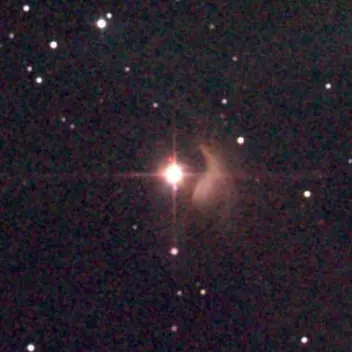
The famous young variable stellar object T Tauri is a prototype for a class of pre-main-sequence objects that bears its name. T Tauri is actually a 0´´.6-separation binary star, unresolved in this image. (The objects very near the star just east of north and just west of south are filter glint artifacts, not infrared companions of T Tau.) The nebula to the west (NGC 1555) is reflected light from T Tauri. Atlas Image mosaic obtained as part of the Two Micron All Sky Survey (2MASS), a joint project of the University of Massachusetts and the Infrared Processing and Analysis Center/California Institute of Technology, funded by the National Aeronautics and Space Administration and the National Science Foundation.
T Tauri itself is a star system consisting of at least three stars. Only one of them can be seen at optical wavelengths, while the other two are visible in the infrared. One of the stars is a source of radio waves.
The T Tauri system is located near the reflection nebula NGC 1555 and illuminates it, causing the nebula to also exhibit variations in brightness.
T Tauri has an apparent magnitude of 10.27 and is approximately 600 light years distant from Earth.
RV Tauri
RV Tauri is a yellow supergiant with the stellar classification G2eIA-M2Ia. Like T Tauri, it is a prototype for its own class of variables. Its brightness varies from magnitude 9.5 to 13.5 over a period of 78.5 days. With the change in luminosity, the star also changes spectral type. When it is at its brightest, it is class G2 and at its dimmest, it is class M2. The star has a circumstellar disk.
RV Tauri is a pulsating variable nearing the final stages of its life. It will soon expel its outer layers to become a planetary nebula and contract into a white dwarf. It is believed to be approximately 7,100 light years distant.
The star’s variability was discovered by the Russian astronomer Lydia Ceraski in 1905.
HD 37124
HD 37124 is a yellow dwarf of the spectral type G4V. It has an apparent magnitude of 7.68 and is about 110 light years distant.
Three extrasolar planets were confirmed to be orbiting the star in 2005. None of the planets are hot Jupiters and they are all either within or near the star’s habitable zone.
The Pleiades – brightest stars:
Alcyone – η Tauri (Eta Tauri)
Alcyone is the third brightest star in Taurus constellation and the brightest member of the Pleiades cluster. It was named after one of the mythological Pleiades. The system has an apparent magnitude of 2.873 and is approximately 370 light years distant from the Sun.
Eta Tauri is an eclipsing binary system composed of two stars separated by 0.031 seconds of arc. The main star in the system, Alcyone A, is a blue-white giant belonging to the spectral class B7IIIe, with a visual magnitude of 2.87. It has ten times the Sun’s radius and is about 2,400 times more luminous. The star is a rapid rotator, with a projected rotational velocity of 215 km/s. It has a disk of gas surrounding it at the equator.
The binary star has three companions – Alcyone B, Alcyone C, and Alcyone D. Alcyone B and Alcyone C are 8th magnitude white dwarfs of the spectral type A, and Alcyone D is a yellow-white dwarf belonging to the spectral class F. Alcyone C is a Delta Scuti variable, exhibiting variations in brightness from magnitude 8.25 to 8.30 every 1.13 hours.
Atlas – 27 Tauri
Atlas is a triple star with a visual magnitude of 3.62, approximately 381 light years distant from the Sun. The star was named after the Titan Atlas, father of the Pleiades.
The primary component in the system, Atlas A, is a blue-white giant with the stellar classification B8 III. It is in fact a spectroscopic binary consisting of components with a visual magnitude of 4.1 and 5.6. The binary star has an orbital period of 1250 days. The primary component has a dim companion 0.4 arc seconds away. The companion, Atlas B, has an apparent magnitude of 6.8.
Electra – 17 Tauri
Electra is a blue-white giant with the stellar classification B6 IIIe. It has an apparent magnitude of 3.705 and is approximately 600 light years distant from Earth. It is the third brightest star in the Pleiades cluster.
Electra is another rapid rotator, with a projected rotational velocity of 181 km/s. As a result of its fast rotation rate, the star is flattened at the poles and stretched at the equator. The star emits an excess level of radiation in infrared, likely as a result of having a gaseous disk which in turn is a result of the mass loss that comes with rapid rotation.
Electra is occasionally occulted by the Moon and less frequently by planets.
Maia – 20 Tauri
Maia is a blue giant belonging to the spectral class B8III. It was named after the eldest of the Pleiades sisters. It has a visual magnitude of 3.871 and is approximately 360 light years distant. It is one of the stars in the Maia Nebula (NGC 1432), a relatively bright emission or reflection nebula located in the Pleiades cluster.
Maia is a mercury-manganese star, a chemically peculiar star that has a prominent spectral line at 398.4 nm as a result of absorption from ionized mercury. It has four solar masses, 5.5 times the solar radius, and is 660 times more luminous than the Sun.
Merope – 23 Tauri
Merope is a blue-white subgiant star belonging to the spectral class B6IVe, approximately 360 light years distant. It has a visual magnitude of 4.113. The star is about 630 times more luminous than the Sun and has 4.5 solar masses. The star’s radius is more than four times solar.
23 Tauri is classified as a Beta Cephei type variable star, exhibiting variations in brightness by 0.01 magnitudes.
The star is surrounded by the Merope Nebula. The Pleiades cluster is currently passing through the nebula, which appears brightest around Merope, which is how the nebula got its name.
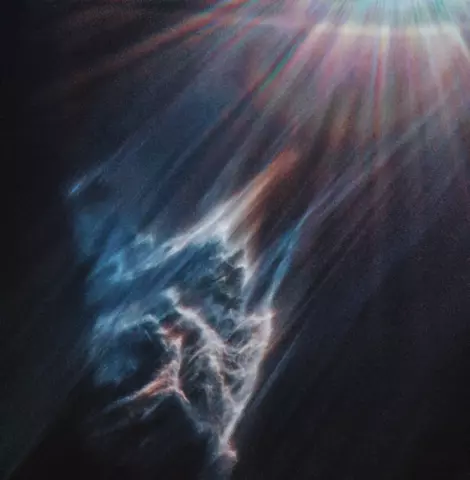
IC 349, image: Judy Schmidt (CC BY 2.0)
Taygeta – 19 Tauri
Taygeta is another triple star system. It has an apparent magnitude of 4.30 and is approximately 440 light years distant from the solar system.
The primary component is a spectroscopic binary star, Taygeta A. The star is a blue-white subgiant with the stellar classification B6IV. Its components have magnitudes of 4.6 and 6.1 and are separated by 0.012 seconds of arc. The two stars complete an orbit around each other every 1,313 days. Taygeta A has an 8th magnitude companion, Taygeta B, separated by 69 arc seconds.
Pleione – 28 Tauri (BU Tauri)
Pleione is a binary star in the Pleiades cluster. It has a visual magnitude of 5.048 and is approximately 392 light years distant. It is difficult to see with the unaided eye because it lies close to the brighter Atlas.
Pleione has the stellar classification B8Ivpe. It is s hot class B star and a classical Be star, one with prominent emission lines of hydrogen in its spectrum. It is an exceptionally fast rotator and rotates close to its breakup velocity. The star is about 190 times brighter than the Sun.
Pleione is a Gamma Cassiopeiae type variable star, showing variations in luminosity between magnitude 4.8 and 5.5. It has the variable star designation BU Tauri.
The star was named after the mythological Pleione, the daughter of Tethys and Oceanus and mother of the Hyas, Hyades and Pleiades.
Celaeno – 16 Tauri
Celaeno (or Celeno) is a blue-white subgiant with the stellar classification B7IV. It has an apparent magnitude of 5.448 and is approximately 430 light years distant from the solar system.
The star is sometimes called the Lost Pleiad because it is the most difficult one of the seven Pleiades sisters to find and it can only be seen without binoculars under good conditions and clear skies.
Celaeno has more than four times the solar radius and is another rapid rotator in the Pleiades cluster. It has a projected rotational velocity of 185 km/s.
Asterope – 21 and 22 Tauri
21 Tauri and 22 Tauri are separated by 0.04° and both lie about 440 light years away in the Pleiades cluster. 21 Tauri is a main sequence dwarf star with the stellar classification B8 V and an apparent magnitude of 5.76. 22 Tauri is also a main sequence dwarf, belonging to the spectral class A0Vn, with a visual magnitude of 6.43.
Deep sky objects in Taurus
Crab Nebula – Messier 1 (M1, NGC 1952)
Messier 1 is a supernova remnant in Taurus. It is also a pulsar wind nebula, or plerion, which is to say a nebula that is powered by the pulsar wind of a pulsar, usually found within shells of supernova remnants. A pulsar, or pulsating star, is an exceptionally magnetized rotating neutron star that emits a beam of electromagnetic radiation.
Messier 1 was discovered by the English doctor and astronomer John Bevis in 1731. It was the first astronomical object to be entered in Messier’s catalogue in 1758.
The nebula is believed to be the remnant of a supernova documented by Chinese, Japanese and Arab astronomers in 1054. Messier 1 was the first deep sky object that was linked to a historical supernova event.
The Crab Nebula has an apparent magnitude of 8.4 and is approximately 6,500 light years distant from the Sun. It is about 11 light years in diameter and expanding at the rate of 1,500 km per second.
The neutron star at the centre of the nebula is known as the Crab Pulsar. The Crab Pulsar is a young neutron star, a remnant of the supernova SN 1054, first identified in 1968. It emits pulses of radiation ranging from gamma rays to radio waves that rotate 30.2 times each second.
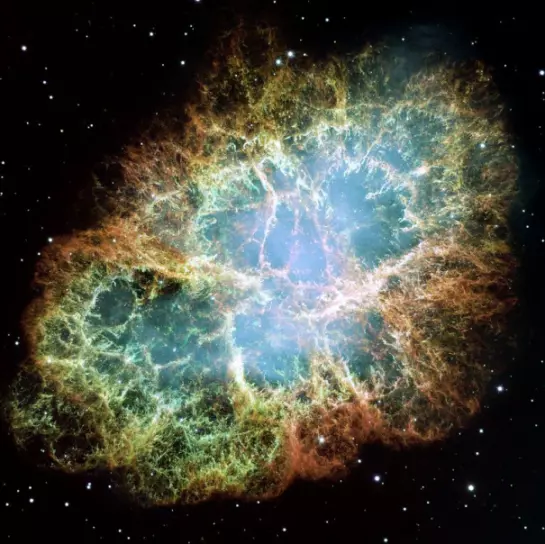
This is a mosaic image, one of the largest ever taken by NASA’s Hubble Space Telescope of the Crab Nebula, a six-light-year-wide expanding remnant of a supernova. Japanese and Chinese astronomers recorded this event nearly 1,000 years ago in 1054, as did, almost certainly, Native Americans. The orange filaments are the tattered remains of the star and consist mostly of hydrogen. The rapidly spinning neutron star embedded in the center of the nebula is the dynamo powering the nebula’s eerie interior bluish glow. The blue light comes from electrons whirling at nearly the speed of light around magnetic field lines from the neutron star. The neutron star, like a lighthouse, ejects twin beams of radiation that appear to pulse 30 times a second due to the neutron star’s rotation. A neutron star is the crushed ultra-dense core of the progenitor star. The Crab Nebula derived its name from its appearance in a drawing made by Irish astronomer Lord Rosse in 1844, using a 36-inch telescope. When viewed by Hubble, as well as by large ground-based telescopes such as the European Southern Observatory’s Very Large Telescope, the Crab Nebula takes on a more detailed appearance that yields clues into the spectacular demise of a star, 6,500 light-years away. Image: NASA, ESA, J. Hester and A. Loll (Arizona State University)
The Pleiades (Seven Sisters) – Messier 45
Messier 45 is an open star cluster in Taurus. It consists mostly of hot, luminous B-class stars most of which have formed in the last 100 million years. It is the best known cluster in the sky, and the easiest one to find, mainly because of its proximity and brightness.
The Pleiades cluster has an apparent magnitude of 1.6 and is 110 arc minutes in size. Its member stars are between 390 and 460 light years distant from the solar system.
The cluster will exist for another 250 million years or so, and then gravitational interactions with nearby objects will cause the stars to disperse. The stars are physically related and they all share the same proper motion.
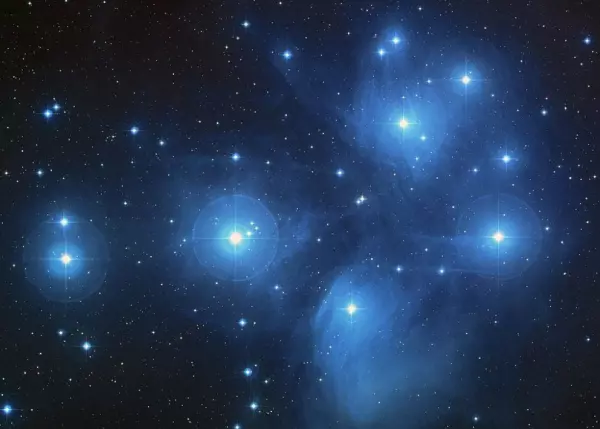
The Pleiades is an open cluster consisting of approximately 3,000 stars at a distance of 400 light-years (120 parsecs) from Earth in the constellation Taurus. (It also known as “The Seven Sisters”, or the astronomical designations NGC 1432/35 and M45.) Image: NASA, ESA, AURA, Caltech, Palomar Observatory
The nine brightest stars in the cluster were named after the Pleiades – the Seven Sisters in Greek mythology – Alcyone, Celaeno, Electra, Maia (mother of the god Hermes), Merope (wife of Sisyphus), Sterope, Taygeta – and their parents, the sea nymph Pleione and the titan Atlas.
In Greek mythology, once Atlas was forced to carry the heavens, Orion started to pursue his daughters. To protect them from his advances, Zeus first transformed the seven sisters into doves and then, to comfort their father, into stars. It is said that the constellation Orion still pursues the Pleiades across the sky.
The cluster is known in many different cultures and the earliest depiction of the cluster dates back to the Bronze Age.
The Hyades Cluster (Caldwell 41, Melotte 25, Collinder 50)
The Hyades is an open cluster that contains hundreds of stars that share the same motion through space, origin, age, and chemical content. It is the nearest open star cluster to the Sun, and consequently the most studied one, too. Its estimated age is about 625 million years.
The brightest stars in the Hyades cluster and Aldebaran, the brightest star in Taurus, form a V shape. Aldebaran is not a member of the cluster, but lies in the same line of sight. It is much closer to us than the Hyades.
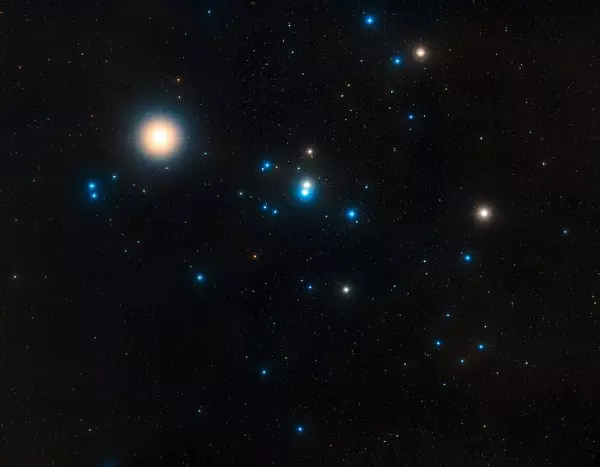
This image shows the Hyades star cluster, the nearest cluster to us. The Hyades cluster is very well studied due to its location, but previous searches for planets have produced only one. A new study led by Jay Farihi of the University of Cambridge, UK, has now found the atmospheres of two burnt-out stars in this cluster — known as white dwarfs — to be “polluted” by rocky debris circling the star. Seeing evidence of asteroids points to the possibility of Earth-sized planets in the same system, as asteroids are the building blocks of major planets. Planet-forming processes are inefficient, and spawn many times more small bodies than large bodies — but once rocky embryos the size of asteroids are built, planets are sure to follow. Image: NASA, ESA, and STScI
The four brightest stars in the cluster – Gamma, Delta, Epsilon and Theta Tauri – are red giants and they all lie within a few light years of each other. They form an asterism that represents the bull’s head.
The Hyades cluster has an apparent magnitude of 0.5 and is about 153 light years distant. The core of the cluster, densely populated with stars, has a diameter of 17.6 light years.
The cluster was named after the Hyades, five daughters of the titan Atlas and half-sisters to the Pleiades. It is said that, when they brother Hyas passed, the sisters were transformed into a star cluster, which was later associated with rain. In England, the cluster was sometimes known as the April Rainers.
Hind’s Variable Nebula – NGC 1555
NGC 1555 is a variable nebula in Taurus. It is a reflection nebula that exhibits variations in luminosity as a result of changes in its star. It lies next to the star T Tauri and is illuminated by the star’s light.
The nebula was first discovered by the English astronomer John Russell Hind on October 11, 1852.

NGC 1555, image: Adam Block, Mount Lemmon SkyCenter, University of Arizona (CC BY-SA 3.0 US)
NGC 1410 and NGC 1409
NGC 1409 (right) and NGC 1410 (left) are a set of colliding galaxies in Taurus constellation. The two are connected by a pipeline of gas spanning over 20,000 light years that is being funnelled from one galaxy to the other. As a result, there is a lot of star forming activity occurring in NGC 1410, the galaxy that is on the receiving end. NGC 1409, on the other hand, is devoid of young blue stars.
The pair has an apparent magnitude of 15.4 and is 300 million light years distant from the Sun. The galaxies are gravitationally bound and will eventually merge into one.
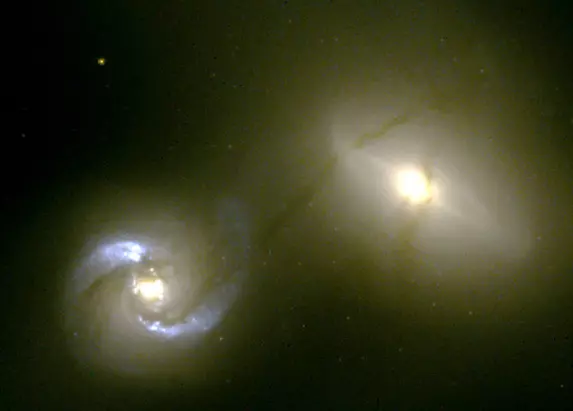
This visible-light picture, taken by NASA’s Hubble Space Telescope, reveals an intergalactic “pipeline” of material flowing between two battered galaxies that bumped into each other about 100 million years ago. The pipeline (the dark string of matter) begins in NGC 1410 (the galaxy at left), crosses over 20,000 light-years of intergalactic space, and wraps around NGC 1409 (the companion galaxy at right) like a ribbon around a package. Although astronomers have taken many stunning pictures of galaxies slamming into each other, this image represents the clearest view of how some interacting galaxies dump material onto their companions. Image: NASA, William C. Keel (University of Alabama, Tuscaloosa)
Crystal Ball Nebula – NGC 1514
NGC 1514 is a large planetary nebula in Taurus. It was first discovered by William Herschel in November 1790. The nebula is believed to be surrounding a close binary star with an orbital period of up to 10 days.
NGC 1514 has an apparent magnitude of 9.43.
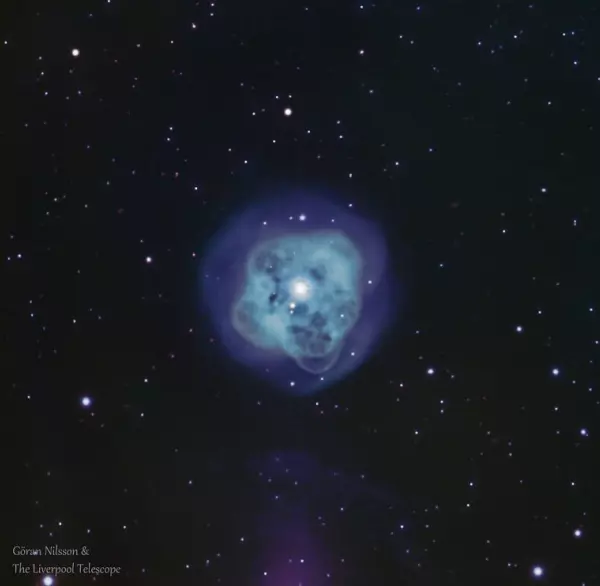
Crystal Ball Nebula (NGC 1514), image: Göran Nilsson & The Liverpool Telescope (CC BY-SA 4.0)
NGC 1746
NGC 1746 is an asterism or open cluster in Taurus. It was discovered by Heinrich Louis d’Arrest in 1863. The object has a visual magnitude of 6.1 and is 42 arc minutes in diameter.
Merope Nebula (Tempel’s Nebula) – NGC 1435
The Merope Nebula is a diffuse reflection nebula located in the Pleiades star cluster. It surrounds the star Merope (23 Tauri) and is illuminated by the star’s light. The nebula is a suspected supernova remnant. The Merope Nebula envelops IC 349 (Barnard’s Merope Nebula), a bright nebula 0.06 light years from the star Merope.
NGC 1435 was discovered by the German astronomer Wilhelm Tempel. It has an apparent magnitude of 13.0 and is approximately 440 light years distant from the solar system.
NGC 1647
NGC 1647 is another open cluster in Taurus, located between the bull’s horns. It has an apparent magnitude of 6.4.
NGC 1817
NGC 1817 is also an open star cluster. It was discovered by William Herschel on February 19, 1784. The cluster has an apparent magnitude of 7.7.
NGC 1807
NGC 1807 is another open cluster in Taurus. It was discovered by John Herschel on January 25, 1832. It has a visual magnitude of 7.0.